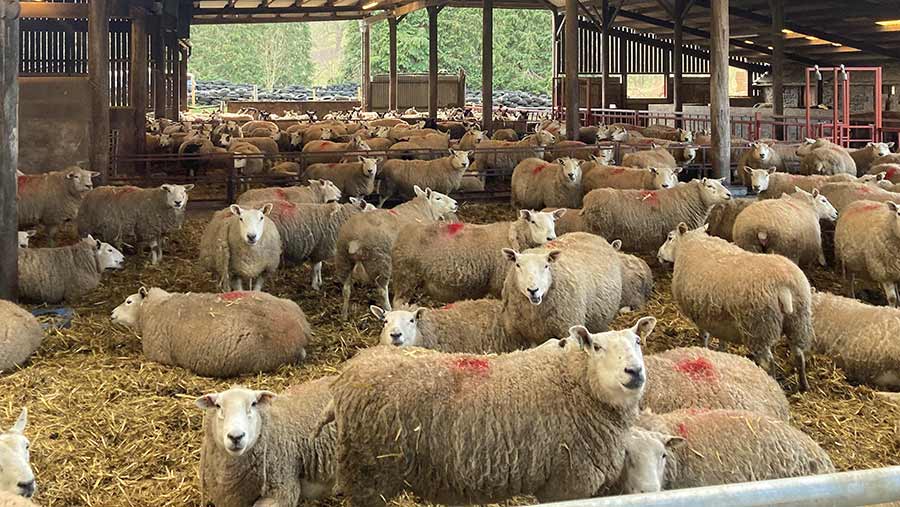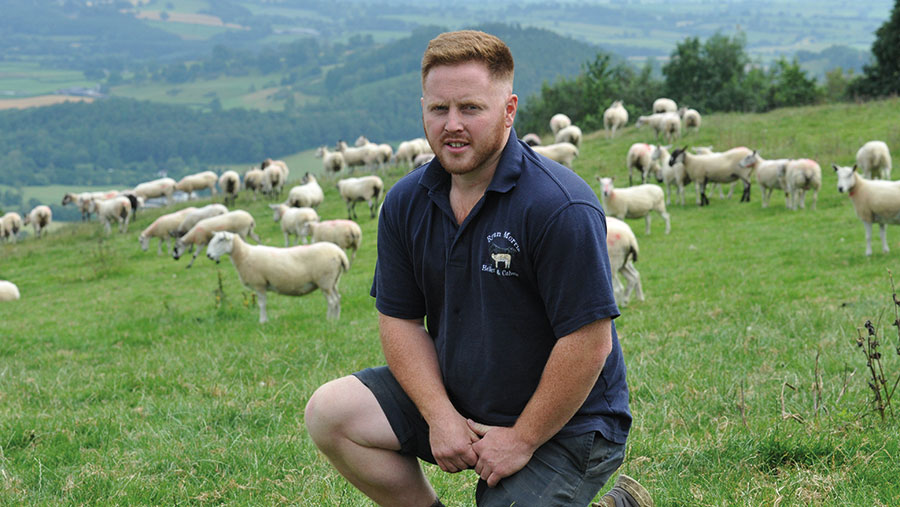Housing and hygiene tweaks help cut cases of ewe mastitis
 © Alana Jackson
© Alana Jackson Improvements in management and housing on a Welsh sheep farm have helped cut mastitis rates by one-third.
Mastitis had been a major cause of losses in Ryan Morris’ flock of nearly 1,000 ewes at Maestanyglwyden, near Oswestry.
About 10% of the flock – 90-100 ewes – would get mastitis every year.
“We had problems throughout the year, although the spring was the worst time,” says Mr Morris, who took over the farm from his grandfather five years ago and now farms with his partner, Rebecca Greaves.
See also: Survey identifies most problematic sheep and cattle diseases
Milk sampling had shown the presence of the mastitis-causing bacteria Staphylococcus aureus (S aureus) and Mannheimia haemolytica.

Ryan Morris © Debbie James
Farm trial
Farming Connect set up a farm trial alongside the farm’s vets, Cain Farm Vets, to find out what factors were influencing the high incidence of mastitis and to help inform a plan to reduce rates.
The trial monitored the mastitis incidence rate in 439 twin-bearing ewes from the March-lambing flock.
Ewes were vaccinated with Heptavac P, a clostridial vaccine containing Mannheimia haemolytica, and a booster administered four weeks before lambing.
Maestanyglwyden farm facts
- 162ha (400 acres farmed
- Texel-cross, Mule and Beltex-cross flock
- Main flock scan at 195%
- Ewe lambs scan at 145%
- Lambs from February to April
- Lambs sold liveweight at Welshpool and Oswestry marts
Blood sampling was used to assess flock nutrition three weeks before lambing; this established that the diet was meeting the protein and energy requirements of the ewes during late gestation.
1. Housing and hygiene
The first part of the trial was to see what effect improvements in housing and hygiene had on mastitis rates.
Mr Morris reduced stocking density by:
- Increasing floor space by one-sixth to cut the pathogen load within the shed
- Increasing the number of dedicated small pens for freshly lambed ewes so ewes could be moved out of the main lambing area into clean pens within two hours.
He also paid closer attention to cleanliness – all staff wore arm-length, disposable gloves for lambing and short gloves for jobs such as putting lambs to suckle, to reduce the risk of bacteria spreading between sheep and onto teats.
Results
When the study concluded in July 2021, the overall mastitis rate for the whole flock was found to have fallen from the five-year average of 10% to 6.8%.
Cain Farm Vets’ Alana Jackson, who instigated the trial, puts this down to a combination of factors, notably reduced stocking density and improved hygiene.
“Reducing the pathogen load ewes are exposed to at the point of lambing, when their immune system is most suppressed, will have had a big effect,” she says.
Continuing to feed ewes with 0.9kg a head a day of an 18% sheep nut plus ad-lib hay until peak lactation and six weeks after turnout, when the rate was reduced to 0.45kg a head a day, will also have helped by ensuring milk production was sufficient, she adds.
If a ewe isn’t producing enough milk, lambs will suckle more frequently and this can cause teat damage, increasing the risk of a ewe developing mastitis.
Ms Jackson says mastitis in ewes is more of an issue on some farms than others.
“It is a multi-factorial disease, which makes control difficult,” she admits.
“This field trial just shows that tweaking several aspects of management in the flock has had a positive effect. However, there is no silver bullet.”
2. Vaccination
The second part of the trial involved vaccinating ewes to protect them against mastitis caused by S aureus.
Half of the study group was vaccinated.
Results
Analysis of the data (see “Comparison of cases of mastitis in vaccinated and unvaccinated ewes”) showed there was no statistical difference in mastitis rates between the vaccinated and unvaccinated groups in this small trial, according to Ms Jackson.
But she warns against drawing conclusions from this, as the study only involved 439 ewes.
“The positive effect of the vaccine could be subtle, and having more ewes in the study may have shown that vaccinated ewes did have a significantly reduced mastitis incidence rate,’’ says Ms Jackson.
She believes that boosting the ewes’ immunity to S aureus with the vaccine will have improved immunity.
Comparison of cases of mastitis in vaccinated and unvaccinated ewes |
|||
|
|
Vaccinated |
Unvaccinated |
Total |
|
Average body condition score |
3.53 |
2.86 |
|
|
Total number of animals in trial |
225 |
214 |
439 |
|
Number of cases of mastitis |
14 |
16 |
30 |
|
Percentage of mastitis cases |
6.22 |
7.48 |
6.8 |
3. Temperature and rainfall
In the third part of the trial, temperature variation and rainfall patterns at Maestanyglwyden were recorded to establish if there was any correlation between mastitis rates and changes in weather.
In adverse weather conditions, lambs have an increased energy demand to keep warm. This can result in them suckling more frequently, causing teat damage, which is a known mastitis trigger.
Results
Data collected showed a large variation in temperature and rainfall throughout the trial.
Eight cases of mastitis occurred within 23 days between mid-April and early May. However, this may have been because the ewes were in peak lactation, rather than because of the effect of any weather patterns, Ms Jackson advises.
“This peak in cases didn’t occur during the wettest time, either, but several weeks after the largest rainfall volume measured,” she adds.
A further 17 cases of mastitis were detected at weaning.
No correlation with weather can be made on this cluster, as these were chronic cases that had been missed during lactation, and were found when checking udders at weaning, says Ms Jackson.
“It does highlight that more than half of the mastitis incidents were only identified at weaning,” she says.
However, if these ewes did not present as sick, but were sub-clinically infected, earlier detection might not have been possible. As a result, they would not have received any treatment and their lambs would not have received additional supplementary feeding.
This highlights how sub-clinical mastitis during lactation can cause production losses through reduced milk production, resulting in reduced lamb growth, says Ms Jackson.
“Further trial work, with a larger number of flocks involved, would be useful to see if there are any patterns in weather that could predict the chance of a mastitis case occurring.
“We can’t alter what the weather throws at us, but having risk periods flagged up means vigilance could be increased, or supplementary feed offered to reduce the stress on the ewes and so, potentially, reduce mastitis rates.”
